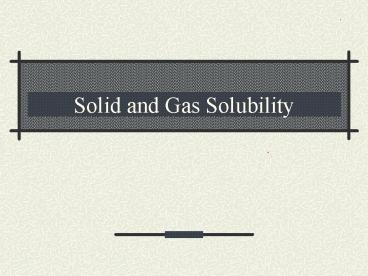Solid and Gas Solubility - PowerPoint PPT Presentation
1 / 25
Title:
Solid and Gas Solubility
Description:
Simply put, solubility is dissolving one thing into something else. ... Every compound has a distinct solubility thus making this a physical property. Gas Solubility ... – PowerPoint PPT presentation
Number of Views:82
Avg rating:3.0/5.0
Title: Solid and Gas Solubility
1
Solid and Gas Solubility
2
What is Solubility?
- Simply put, solubility is dissolving one thing
into something else. - Sugar in water, salt in water.
- Specifically, it is the maximum amount of solute
that will dissolve in a certain amount of water.
3
Solubility Details
- Remember, solute is what you are dissolving and
solvent is what is doing the dissolving. - The amount of solute is expressed in grams.
- The amount of solute dissolved is dependant on
the temperature of the solvent.
4
Lets say it again!
- If you change the temperature of the solvent, the
amount of solute that will dissolve will also
change. - If you change the amount of solvent, the amount
of solute that will dissolve will change.
5
How long does it take?
- Many factors affect the amount of time it takes
for a solute to dissolve.
6
How long does it take to dissolve?
- How soluble the solute is.
- How big the crystals are.
- How much you stir.
- How long you stir the solution.
7
How long does it take to dissolve?
- These factors do not affect the total amount of
solute that will dissolve, only the time it takes
to dissolve. - For example, stirring rapidly and for an extended
time period does not change how much sugar you
can dissolve in Kool-aid, only how long it takes
for the sugar to dissolve.
8
A Specific Amount
- Because there are specific amounts of solutes
that can be dissolved in solvents, there are 3
definitions that we can now use to describe
solutions. - Unsaturated
- Saturated
- Supersaturated
9
Unsaturated Solutions
- If a solution is unsaturated, then the solvent
can dissolve more solute at that temperature.
10
Saturated Solutions
- If a solution is saturated, then it has dissolved
the exact amount it can at that given temperature.
11
Supersaturated Solutions
- If a solution is supersaturated, then it is has
dissolved more solute than a saturated solution
has. - This is difficult to achieve.
- Usually requires heating and then slowly cooling
the solution. - Will eventually release some dissolved solute to
return to a saturated state.
12
How can we tell the kind of solution?
- In order to know when our solutions are saturated
or not, we have to know the solubility of the
solute. - To do this, we look at a solubility curve.
13
Solubility Curves
- A solubility curve graphs the temperature of the
solvent versus the grams of solute dissolved in a
given amount of solvent. - This curve shows the solubility for a range of
temperatures.
14
Solubility Curves
- In addition to showing us saturated solutions,
they also can be used to determine if a solution
is supersaturated and unsaturated.
15
Solubility Curve Example
16
An Unsaturated Solution
A point here would be unsaturated
17
A Saturated Solution
A point here would be saturated
18
A Supersaturated Solution
A point here would be supersaturated
19
Solid and Gas Solubility
- The 3 phases of matter all behave differently
with solubility. - We will discuss how solids and gases differ in
solubility.
20
Solid Solubility
- By studying solubility graphs, a general trend
can be seen. - As you increase temperature, the solubility also
increases. - At higher temps, you can dissolve more.
21
Solid Solubility
- A positive slope on the curve indicates this
trend. - Every compound has a distinct solubility thus
making this a physical property.
22
Gas Solubility
- As with solids, temperature affects the
solubility of gases. - But, the trend is opposite, as you increase the
temperature, the solubility decreases.
23
Gas Solubility
- In addition to temperature affecting gas
solubility, gas pressure also determines the
solubility of a gas. - Gas solubility is directly proportional to the
gas pressure. - The higher pressure, the more gas that will
dissolve.
24
A Good Example
- Carbonated beverages contain dissolved CO2.
- When you open a can of soda, the pressure is
decreased and the amount of CO2 dissolved also
decreases. Thats why you see bubbles coming up.
25
Solution Concentration

















![Lecture note : Gas chromatography [1] ????????? PowerPoint PPT Presentation](https://s3.amazonaws.com/images.powershow.com/6692254.th0.jpg?_=20150604093)













